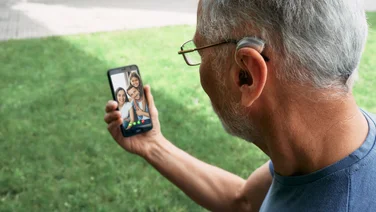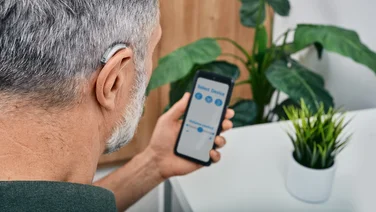To help us provide you with free impartial advice, we may earn a commission if you buy through links on our site. Learn more

Hearing aids don’t have to cost anything in the UK. But not everyone qualifies for an NHS hearing aid, and not everyone wants one. If you want the latest sound-enhancing technology and your choice of model, style and functionality, then it pays to buy. But how much do hearing aids cost?
Modern digital hearing aids from a big brand such as Signia, Phonak or Unitron start at around £500/pair. Hearing aids at this price can make all the difference if you suffer from mild hearing loss and don’t tend to go to noisy places. However, if you want really powerful sound technology and advanced features, you can pay more than £3,500/pair. The average price at retailers such as Hearing Direct and Boots is around £2,500/pair.
That’s a pretty penny, but good hearing aids can last five to seven years. If you use them every day, that £2,500 price tag works out at around £1 a day, for a device that combats isolation and transforms lives. Below, we’ll find out more about what you get for your money.
If you have an idea of your requirements, you can use our free quote finder tool to be matched to a local hearing aid specalist.
READ NEXT: How do hearing aids work?
Get a free hearing aid quote today
Looking to cut to the chase? Take our quick survey below and we’ll provide you with a quote for hearing aids that matches your exact requirements.
How much do budget hearing aids cost?
You can buy a pair of basic amplifiers from Amazon for as little as £69. They look like behind-the-ear (BTE) hearing aids, but they’re not. As explained in our article How do hearing aids work?, modern hearing aids are not just amplifiers. They selectively block and minimise sound, for example in noisy settings, and use sound-enhancing technology to clarify speech for easier communication. If you want affordable hearing aids that achieve that, expect to spend from around £500-£1,000/pair. In this price range, you’ll find digital hearing aids that:
- Enhance and clarify sound rather than just amplifying it;
- Support Bluetooth for remote control, apps and multimedia connectivity;
- Have a remote control app for volume and preset control;
- Have disposable batteries rather than rechargeables;
- Are discreet in-the-ear (ITE) hearing aids or larger behind-the-ear (BTE) hearing aids, depending on your preference;
- Improve your hearing if you suffer mild to moderate hearing loss;
- Suit you if you mainly use your hearing aids at home, and when speaking one-to-one in person or on the phone.
You may not see budget hearing aids in the most prominent places on retailers’ websites, so we went looking for them. One of the best deals we found was the Hearing Direct HD 230, a discreet ITE digital hearing aid currently on special offer at £370/pair or £206 each (normally £230 each).

Up the price scale slightly is the popular Signia Silk 1Nx (£598/pair or £349 each from Hearing Direct). These tiny ITE hearing aids are colour-coded so you instantly know which one is left or right, and they have four sound environment presets, although the ability to minimise background noise may be limited in this price range. The free Signia app works as a remote control for all Signia hearing aids, and also lets you keep an eye on your hearing aid’s battery and connectivity.
If you want the increased power of behind-the-ear (BTE) hearing aids but don’t want to break the bank, look at the Signia Motion 13 1Nx (£500/pair, £299 each from Hearing Direct). It’s ergonomically shaped and has a remote mic, special iPhone setting and TV streaming support, plus presents, remote control and Signia app support.
How much do hearing aids cost for moderate hearing loss?
Budget hearing aids may not be powerful enough if you suffer from moderate hearing loss, or if you struggle to hear in noisy settings such as restaurants, schools and busy streets. Hearing aids that genuinely help in this situations tend to cost around £1,000-£2,000/pair.
In this price range, you may need to choose between greater sound-enhancing power and advanced features, rather than getting the whole kit and caboodle. But you’re likely to find digital hearing aids that:
- Suppress noise in noisy places and clarify speech in social situations;
- Have a remote control app for customising your noise environment presets;
- Offer automatic volume regulation, for example instantly suppressing loud and uncomfortable sounds;
- Have rechargeable batteries;
- Are discreet in-the-ear (ITE) hearing aids or larger behind-the-ear (BTE) hearing aids, depending on your preference;
- Improve your hearing if you suffer moderate to severe hearing loss;
- Suit you if you use your hearing aids out and about as well as at home.
The Signia Pure Charge&Go 1AX (£1,295/pair, £695 each from Hearing Direct) behind-the-ear (BTE) hearing aid is smaller and slimmer than many BTE models, and is packed with 16 preset channels that let you quickly switch between all sorts of sound environments.
If you’d prefer a discreet, comfortable ITE hearing aid but you want to make sure it’s powerful enough to help you hear conversations in noisy places, the Signia Silk 7Nx (£1,168/pair or £649 each) offers advanced sound quality, plus seven levels of noise reduction and tinnitus masking customised to your preferences. It packs all this power into a tiny unit that fits right inside your ear canal.
Specsavers has a good choice of hearing aids in this price range, and it rates them out of five for ‘sound quality’ and ‘suitability in social situations and crowds’. The Advance Plus (£1,195/pair) scores two on both counts, the Advance Premium (£1,495/pair) scores three, and the Advance Super (£1,795) scores four.
READ NEXT: Specsavers hearing aid prices, explained
How much do hearing aids cost for severe hearing loss?
You don’t have to buy top-price premium hearing aids to help you with severe hearing loss. But if you want to keep the price down, you’ll need to sacrifice a few extra features.
For example, the best-selling Unitron Moxi Blu 3 (£1,795/pair, £945 each from Hearing Direct) is a rechargeable BTE hearing aid with only two preset environments. However it packs enough sound enhancing power to be suitable for people with severe hearing loss, as well as moderate. It’s built to last, with waterproofing (enough for swimming and heavy rain) and dirt and dust protection.
If you can spend a bit more, premium hearing aids help with severe hearing loss and also offer an array of features. In the £2,500+ price bracket, you’ll find features such as smart automatic noise management, health monitoring and advanced smart home connectivity, as well as superb sound-processing technology.
The Styletto 7AX (£2,895/pair or £1,595 each from Hearing Direct) ergonomic BTE hearing aid has won industry awards for its ability to clarify speech in all kinds of noise environments. It has no fewer than 48 sound-processing channels, and constantly adjusts in real time using continuous analysis of your surrounding acoustics.
The waterproof Phonak Audeo Life Lumity (£3,645/pair from Boots) BTE hearing aids have SmartSpeech technology for challenging sound environments, health data tracking and compatibility with Phonak home devices. It still can’t help restore hearing for completely deaf people, but this powerful hearing aid is one of few that’s able to enhance sound for people with profound hearing loss.
Tiny in-the-ear (ITE) hearing aids tend not to be powerful enough to help with severe hearing loss, but BTE models in this price bracket are carefully designed for comfort and discretion. And if your fingers are less dextrous than they used to be, you’ll find BTE hearing aids less fiddly to handle than ITE models.
Interested in finding out how much hearing aids could cost you?
Find the best provider for you
Do I really need two hearing aids, or can I just buy one?
Buying a single hearing aid saves you money, of course, and might allow you to buy one really good hearing aid rather than a pair of more affordable budget hearing aids. And if you only have hearing loss in one ear, for example following an accident, then it makes absolute sense. However, most hearing loss is gradual and occurs in both ears (bilateral), and often co-occurs with tinnitus. When that’s the case, you’ll have much better experience wearing two hearing aids.
Our brains simply work better in stereo. You’ll find it easier to process sound waves, and you’ll be better able to tell where a sound is coming from, for example when crossing the road. Some hearing aids are designed to work in pairs, too. High-end hearing aids frequently stream sound to both ears if, for example, you’re using one ear to take a phone call.
The days of cumbersome single-ear NHS hearing aids are long gone. Nowadays, these devices are more like earbuds – and like earbuds, they work best in pairs.






